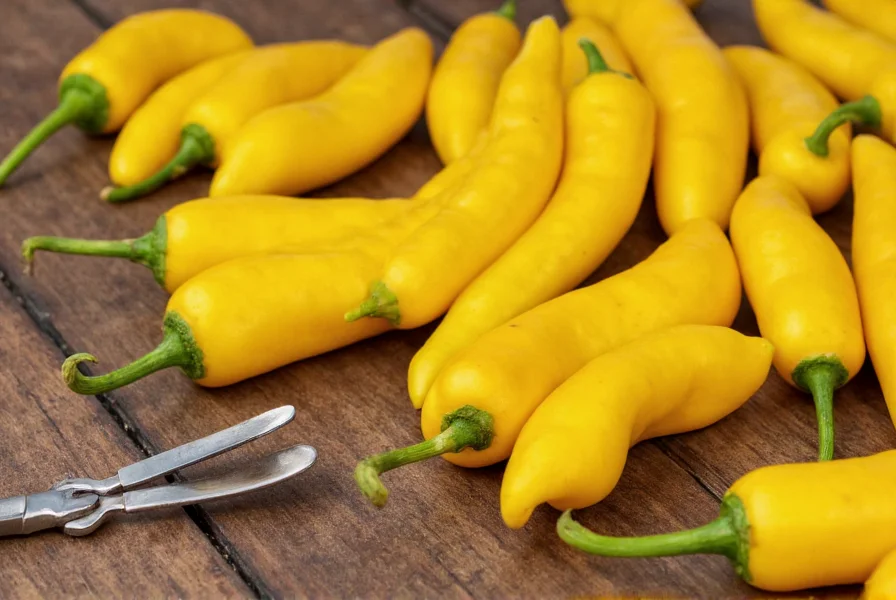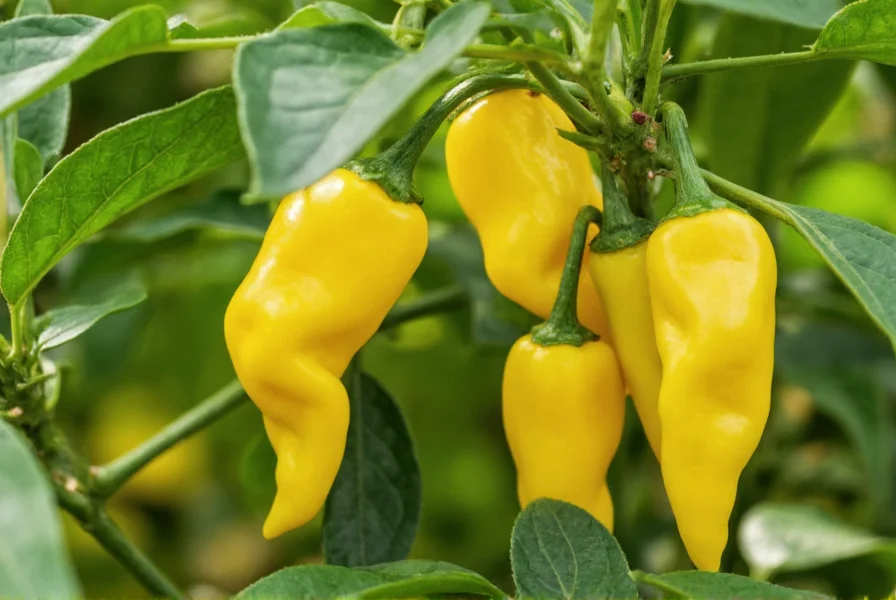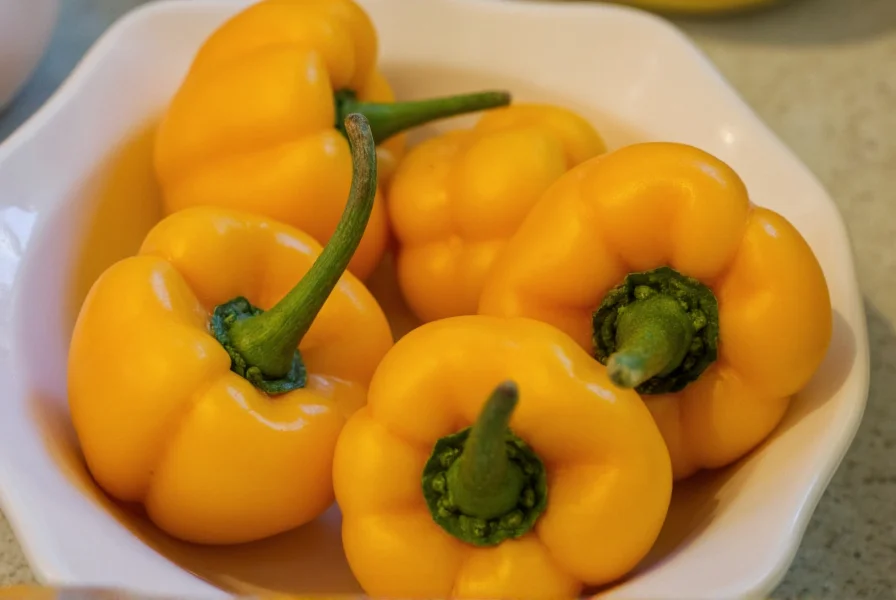When exploring the world of yellow chili peppers, you'll discover they represent a specific ripening stage rather than a single variety. As chili peppers mature from green to yellow, their chemical composition changes significantly, resulting in altered flavor profiles and heat levels. This transformation occurs naturally as chlorophyll breaks down and carotenoids develop, creating that characteristic golden hue.
Understanding Yellow Chili Varieties
Several popular chili varieties reach a yellow stage during their ripening process. The Yellow Wax pepper, often mistaken for a banana pepper, offers mild heat (0-5,000 SHU) with a waxy texture. Yellow Habaneros, meanwhile, pack considerable punch at 100,000-350,000 SHU while delivering distinctive tropical fruit notes. Other common yellow varieties include Yellow Serranos (10,000-25,000 SHU) and Yellow Scotch Bonnets (100,000-350,000 SHU).
| Yellow Chili Variety | Heat Level (SHU) | Flavor Profile | Common Culinary Uses |
|---|---|---|---|
| Yellow Wax | 0-5,000 | Sweet, mild, slightly tangy | Pickling, sandwiches, salads |
| Yellow Habanero | 100,000-350,000 | Tropical fruit, citrus, floral | Salsas, hot sauces, Caribbean dishes |
| Yellow Serrano | 10,000-25,000 | Grassy, bright, moderately hot | Pico de gallo, guacamole, Mexican cuisine |
| Yellow Scotch Bonnet | 100,000-350,000 | Fruity, smoky, intense heat | Caribbean jerk sauces, stews, marinades |
Yellow vs. Red Chili Peppers: Key Differences
The color transformation from green to yellow to red represents different ripening stages that significantly impact flavor and heat. Yellow chilies generally contain higher concentrations of certain carotenoids and lower capsaicin levels than their fully red counterparts. This results in a more complex flavor profile with pronounced citrus and tropical fruit notes while maintaining moderate heat.
From a culinary perspective, yellow chilies work exceptionally well in dishes where you want noticeable heat without overwhelming spiciness. Their bright color adds visual appeal to salsas, salads, and garnishes. Chefs often prefer yellow varieties for raw applications since their milder heat allows the nuanced flavors to shine through without dominating other ingredients.

Culinary Applications of Yellow Chili Peppers
Chefs value yellow chilies for their versatility across multiple cuisines. In Mexican cooking, yellow serranos enhance fresh salsas and guacamole with bright heat that complements avocado's richness. Caribbean chefs utilize yellow Scotch Bonnets in jerk marinades where their fruity notes balance traditional allspice and thyme.
For home cooks exploring yellow chili recipes, consider these applications:
- Create vibrant yellow chili oil by infusing mild vegetable oil with sliced yellow chilies
- Add diced yellow habaneros to mango salsa for tropical flavor combinations
- Blend yellow serranos into mayonnaise for spicy sandwich spreads
- Roast yellow chilies and incorporate into cornbread or muffins
- Preserve yellow chilies through pickling for year-round use
Growing Yellow Chili Peppers
Gardeners can cultivate yellow chilies with relative ease, as most varieties share similar growing requirements with other chili peppers. Start seeds indoors 8-10 weeks before last frost, maintaining soil temperatures between 70-85°F (21-29°C). Transplant outdoors after danger of frost has passed, spacing plants 18-24 inches apart in full sun locations.
Yellow chili varieties typically require 70-90 days from transplanting to reach the yellow ripening stage. Unlike some red varieties that continue ripening after picking, yellow chilies should be harvested at peak color for optimal flavor. Regular harvesting encourages continued production throughout the growing season.

Nutritional Benefits of Yellow Chili Peppers
Yellow chilies offer impressive nutritional advantages beyond their culinary appeal. They're exceptionally rich in vitamin C—containing up to three times more than oranges by weight. The carotenoids responsible for their yellow color function as powerful antioxidants that support eye health and immune function.
Research indicates that capsaicin, the compound creating chili heat, may boost metabolism and provide pain relief when consumed regularly. Yellow chilies also contain significant amounts of vitamin A, potassium, and B vitamins, making them valuable additions to balanced diets.
Storage and Preservation Techniques
Proper storage extends yellow chili shelf life while maintaining flavor integrity. Refrigerate unwashed peppers in perforated plastic bags for up to three weeks. For longer preservation, consider these methods:
- Freezing: Blanch whole peppers for 2 minutes, cool in ice water, then freeze in airtight containers
- Drying: Use a food dehydrator or oven on lowest setting until brittle, then store in glass jars
- Pickling: Preserve in vinegar-based brine with garlic and spices for refrigerator pickles
- Oil infusion: Create chili oil by steeping sliced peppers in high-quality olive oil
Common Misconceptions About Yellow Chilies
Several myths persist about yellow chili peppers that deserve clarification. Contrary to popular belief, yellow chilies aren't inherently milder than red varieties of the same type—heat levels depend more on growing conditions than color alone. The yellow color doesn't indicate immaturity; many varieties naturally ripen to yellow before turning red.
Another misconception suggests yellow chilies lack nutritional value compared to darker varieties. In reality, their unique carotenoid profile offers distinct health benefits. Understanding these facts helps cooks make informed choices when selecting yellow chili peppers for specific culinary applications.











 浙公网安备
33010002000092号
浙公网安备
33010002000092号 浙B2-20120091-4
浙B2-20120091-4